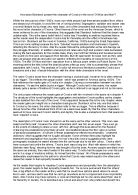Symbolism in The Great Gatsby.
Symbolism in The Great Gatsby By 1925, author F. Scott Fitzgerald was known primarily as the historian of the Jazz Age and chronicler in slick American weeklies of the American flapper. Perhaps this is why critics and reviewers were caught off-guard in that year, at the height of the Roaring Twenties, when Fitzgerald published The Great Gatsby, a story cited today as the Great American Novel. It is true, as Magnum Bryant says, "The simple romance of Jay Gatsby and Daisy Buchanan is merely the foundation for a narrative structure that accommodates Fitzgerald's ideas about irreconcilable contradictions within the American Dream and ultimately about the ideal quest itself"(Byrant n.pg.). The intricate weaving of the various stories within The Great Gatsby is accomplished through a complex symbolic substructure of the narrative. The primary images and symbols that Fitzgerald employs in developing the theme of The Great Gatsby are the green light, the Valley of Ashes, and the overlooking eyes of Dr. T.J. Eckleburg. The green light at the end of Daisy Buchanan's dock is the first use of one of the novel's central symbols. The initial appearance of the green light occurs when the narrator, Nick Caraway, sees Gatsby standing in front of his mansion, stretching out "his arms toward the dark water in a curious way" (Fitzgerald 26; ch. 1). From his own house Nick believes that he can
Of Mice And Men
Of Mice And Men John Steinbeck uses animal imagery to express and introduce characters, events and themes in 'Of Mice and Men.' Steinbeck also uses nature, to convey events and settings in a subtle way. In section one of 'Of mice and Men' Steinbeck uses various colours to help the reader visualise the clearing as a tranquil and peaceful place. By describing the Salinas River as 'deep and green' the reader instantly envisages the water to be refreshing, mysterious and untouched. In addition, Steinbeck suggests that the clearing is full of sunlight: 'The water is warm too, for it slipped twinkling over the yellow sands.' Yellow, in this context, is calming because the words 'warm' and 'twinkling' are used before it. Steinbeck also uses alliteration to create a calm and peaceful atmosphere: 'south of Soledad, the Salinas River.' The repetition on the soft's' sound is calming and subtle. Steinbeck repeats this technique: 'the water is warm too.' As with the's' sound, the soft 'w' is calming. In this setting of absolute calm and serenity, Lennie and George are introduced. Steinbeck uses extensive animal imagery to describe Lennie: 'dragging his feet in the way a bear drags his paws.' This gives the impression that Lennie is large and cumbersome. However, the main reason that Steinbeck uses this form of imagery in describing Lennie is to portray him as amoral and therefore




















